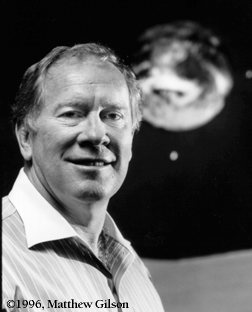One thing I wanted to add to Mark's post about the New Views conference. The conference as a whole was dedicated to the memory of David Schramm, whose 60th birthday would have been this year; he died while piloting his own airplane in 1997. Schramm was an enormously influential figure in contemporary cosmology, one of the prime movers in bringing together particle physics and astrophysics in the study of the early universe. In particular, he was a pioneer in the use of Big-Bang Nucleosynthesis as a way to understand both particle physics and cosmology. Between a few seconds and a few minutes after the Big Bang, the universe was a nuclear reactor, converting nucleons (neutrons and protons) into nuclei of helium, lithium, and deuterium. At very high temperatures the nucleons can't bind together without being knocked apart; at low temperatures they would like to be bound into their lowest-energy state, which would be iron nuclei. But the universe is rapidly expanding, so we get a competition: as the temperature declines and it's possible to form nuclei, the density is also falling, making reactions less frequent. We end up with several light nuclei, but don't have enough time to make anything heavier. The relic abundances of these nuclei depend on everything about physics when the universe was one minute old: particle physics parameters that govern the reaction rates, the number of species that governs the energy density, and the laws of general relativity that govern the expansion of the universe. (For example, if the universe were expanding a little bit faster, the reactions would happen a little bit earlier, implying that fewer neutrons would have decayed, allowing for the production of more helium.) Miraculously, the observed abundances fit precisely onto the predictions that come from extrapolating what we know about physics here and now all the way back to a minute after the Big Bang. The helium abundance provided the first empirical evidence that there were only three families of matter particles, long before Earth-based particle accelerators verified the result. And BBN assures us that Einstein's general relativity works without modification in the very early universe; in particular, we know that Newton's constant of gravitation had the same value then as it does now to within about twenty percent. Personally, I find the success of BBN to be one of the most impressive feats in all of modern science. Here we are, 7,000,000,000,000,000 minutes after the Big Bang, making quantitative statements about what was going on 1 minute after the Big Bang -- and it's a perfect fit. I'll never cease to be amazed that we know exactly what the universe was doing when it was one minute old.
The universe is the poor man's particle accelerator
Explore the significance of Big Bang Nucleosynthesis in early universe study and its relation to particle physics and cosmology.
More on Discover
Stay Curious
SubscribeTo The Magazine
Save up to 40% off the cover price when you subscribe to Discover magazine.
Subscribe













